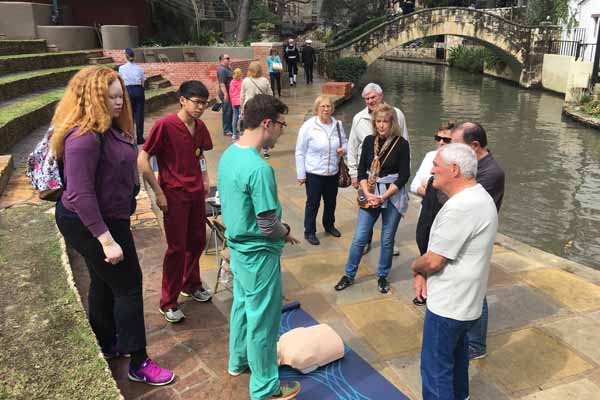
Performing CPR in an emergency can be a scary thing. But the life-saving measure certainly becomes less intimidating when done with simple cues to the beat of the Bee Gees tune, “Stayin’ Alive.”
Ironic? Yes. Memorable? Definitely.
That’s exactly what a Texas medical student-led initiative is going for as it tries to save as many Americans’ lives as possible.
Texas Two Step CPR revolves around educating lay people on hands-only cardiopulmonary resuscitation (CPR). That includes teaching people to do chest compressions to “Stayin’ Alive,” which follows the recommended pace for CPR of roughly 100 beats per minute.
In February — national Heart Awareness Month — the Texas Medical Association-supported Two Step campaign helped train 7,892 people at 60 event sites – including 4,190 people across 20 Texas cities. The initiative originated in the Lone Star State in 2015 and launched nationally this year, expanding to six additional states.
 At the events held in late February, medical student volunteers focused on teaching chest compressions without mouth-to-mouth breaths, which can be daunting for some people. Research shows CPR can be more effective with consistent hands-only compressions versus stopping for breaths, says Weldon Reese Allen. The second-year trainee at University of North Texas Health Science Center at Fort Worth Texas College of Osteopathic Medicine co-chairs an executive board of student representatives from each Texas medical school to coordinate the statewide initiative.
At the events held in late February, medical student volunteers focused on teaching chest compressions without mouth-to-mouth breaths, which can be daunting for some people. Research shows CPR can be more effective with consistent hands-only compressions versus stopping for breaths, says Weldon Reese Allen. The second-year trainee at University of North Texas Health Science Center at Fort Worth Texas College of Osteopathic Medicine co-chairs an executive board of student representatives from each Texas medical school to coordinate the statewide initiative.
“Most people think of TV shows where you have to have a white coat or be in the emergency room (to give CPR), when in reality most cardiac arrests don’t even occur in the hospital,” Mr. Allen said. “There’s no doubt in my mind, and research shows, pre-hospital care plays a big part in saving lives. So we want give people a chance.”
This two-step is certainly no harder than the country-and-western dance it’s named after. Just remember:
- Call 911.
- Push hard and fast in the center of the chest until help arrives.
Texas medical students pioneered Texas Two Step CPR in 2015 and launched the program in 2016 with the help of TMA; the TMA Foundation, the association’s philanthropic arm; the Texas College of Emergency Physicians; and HealthCorps.org, among other supporters. The initiative has since garnered partners from all Texas medical schools, and danced into six other states, with the goal of eventually reaching all 50 states.
This year, 900 medical student volunteers nationwide hit sites that included undergraduate universities, homeless shelters, malls, city parks, and subway stations.
Medical students spend hours in the classroom and in labs, and it takes a few years before they put that training into action as physicians. Mr. Allen says the Two Step CPR initiative gives them opportunities to lead and serve in their communities sooner.
“We gain all of this knowledge. What better way to share it now with future patients?” Mr. Allen asked. “When you look at the field of medicine and what we are all trying to accomplish, at a very elementary level we are trying to improve health, save lives, and educate. This checks all three of those boxes, and it’s something that binds us all together in the medical community.”
Photos courtesy of Texas Two Step CPR